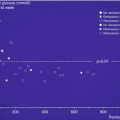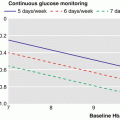© Springer International Publishing Switzerland 2017
Andrea Scaramuzza, Carine de Beaufort and Ragnar Hanas (eds.)Research into Childhood-Onset Diabetes10.1007/978-3-319-40242-0_1111. Risky Behaviours in Teens with Type 1 Diabetes: New Ideas for Research Regarding a Not Too Studied Topic
(1)
Pediatric Diabetology, Metabolic Diseases and Nutrition, Department of Pediatrics, ASST Fatebenefratelli Sacco, Luigi Sacco Hospital, University of Milano, via G.B. Grassi 74, Milan, 20157, Italy
Risk is the potential of gaining or losing something of value. Values (such as physical health, social status, emotional well-being or financial wealth) can be gained or lost when taking risk resulting from a given action or inaction. Risk can also be defined as the intentional interaction with uncertainty.
When talking about health, especially during adolescence, the expression risky behaviour can be defined as the participation in activities that may compromise the physical and mental health of adolescents. Many of these behaviours can be started simply by the explorative character of youths or by the influence of the youths’ environment (peers, family); moreover, if risky behaviour is not identified early, it can lead to the consolidation of these attitudes with significant individual, family and social consequences.
At this respect, it is well known that the majority of morbidity/mortality during adolescence is preventable, and behaviours responsible for leading causes of morbidity/mortality during adulthood are initiated during the second decade of life (e.g. smoking, substance use, physical inactivity, sexual behaviour, driving, etc.).
This is why adolescence is a period of heightened vulnerability and risk taking [1]. Adolescence is one of the most rapid phases of human development, and biological maturity precedes psychosocial maturity. This has implications for policy and programme responses to the exploration and experimentation that takes place during adolescence [2].
The characteristics of both the individual and the environment influence the changes taking place during adolescence.
Younger adolescents may be particularly vulnerable when their capacities are still developing and they are beginning to move outside the confines of their families.
The unique nature and importance of adolescence mandate explicit and specific attention in health policy and programmes. This is particularly true in patients with chronic diseases, like diabetes mellitus [3].
For a long time, it has been assumed that having a chronic condition acted as a protective factor against risky behaviour among chronically ill adolescents, as if they had to follow different paths from their healthy counterparts in their journey from childhood to adulthood. A growing body of literature indicates that adolescents with chronic conditions are as likely, or more likely, to take risky behaviours than their healthy peers [4]. Risky behaviours have negative impact on the health of adolescents and may have worse consequences in vulnerable populations, such as patients with type 1 diabetes mellitus [5–7]. Indeed, in this group of patients, the use of tobacco, alcohol and illicit drugs might be an important factor in the development of acute and chronic complications.
The Youth Risk Behavior Surveillance System [8] measures behaviours that contribute to the leading causes of morbidity and mortality among youth and adults. These are behaviours that contribute to:
Unintentional injuries and violence
Tobacco use
Alcohol and other drug uses
Sexual behaviours
Unhealthy dietary behaviours
Inadequate physical activity
Many of the health problems seen in adolescence start during the first decade, emphasising the need for programming across the life course. The mortality and morbidity/disability patterns of adolescence reflect the transition from childhood to adulthood and the impact of the developmental processes taking place during this period [8].
Why adolescents decide to take risky behaviours may be because of many reasons, among them the most important are poor self-esteem; inadequate social skills; propensity for nonconformity; peers and parents; sometimes neighbourhoods, communities and the media; and finally the impact of culture.
In the case of type 1 diabetes, the reason to take risk may be the disease itself. Adolescents want to verify themselves that they are the same as their nondiabetic peers. Indeed, especially in people with type 1 diabetes, the transition from childhood to adolescence may represent a challenge; the new autonomy can lead to poor self-management and afterwards to a poor glycaemic control [6].
Diabetic adolescents can have deterioration in metabolic control, poor adherence to therapy, risky behaviours, eating disorders and endocrine changes associated with puberty [6].
Surveys provide information on health-related behaviours among adolescents, but the measures vary between surveys, and on some important issues, only a small number of countries have data.
This is the main reason a society as ISPAD (International Society for Pediatric and Adolescent Diabetes) needs to encourage multinational survey about risk-taking behaviours in adolescents with type 1 diabetes around the world.
In the fraction of countries with survey data, 5–15 % of younger adolescents (aged 13–15) reported a suicide attempt in the 12 months before the survey [9].
Less than one in every four adolescents from countries with survey data meets recommended guidelines for physical activity [9].
The same survey showed that up to one in every three adolescents is obese in some countries [9]. In over half the countries in every region, at least half of younger adolescent boys report serious injuries in the preceding year [9]. In most countries half or more of 15-year-olds who are sexually active report using condoms the last time that they had sex [9], meaning that quite half of them undergo sexual intercourse without any protection towards unplanned pregnancies and sexually transmitted diseases.
On the other side, it seems that cigarette smoking is decreasing among younger adolescents in most high-income countries and in some middle- and low-income countries.
Coming back to adolescents with type 1 diabetes and risk-taking behaviours, data reported are still few and someway not concordant [5, 6, 10–12], with some studies reporting lower rate of such behaviours and other higher rates.
The observed inconsistency of results from various studies on risky behaviours among adolescents with type 1 diabetes mellitus is mostly due to methodological differences as well as different times of performing them. It is difficult to compare the results from studies done at our days with those obtained 10–30 years ago.
In a study from our group on a large sample of teenagers with type 1 diabetes like some years ago [6], we have observed that they are as likely or in some instances more likely to take risky behaviours than their nondiabetic peers, especially in the female group. Growing evidence suggests that young people with chronic conditions are doubly disadvantaged – engaging in risky behaviours to at least similar or even higher rates as healthy peers, while having the potential for greater adverse health outcomes from these behaviours [13], like severe hypoglycaemia and macroangiopathic or microangiopathic complications, as in teens with type 1 diabetes.
11.1 Sexual Behaviour
The sexual behaviour of adolescents is, in most cases, influenced by their culture’s norms and mores, their sexual orientation and the issues of social control such as age of consent laws.
In humans, mature sexual desire usually begins to appear with the onset of puberty. Sexual expression can take the form of masturbation or sex with a partner. Sexual interests among adolescents, as among adults, can vary greatly. Sexual activity in general is associated with various risks including unwanted pregnancy and sexually transmitted diseases including HIV/AIDS.
The risks are elevated for young adolescents because their brains are not yet mature; several brain regions in the frontal lobe of the cerebral cortex and in the hypothalamus important for self-control, delayed gratification and risk analysis and appreciation are not fully mature. The creases in the brain continue to become more complex until the late teens, and the brain is not fully mature until age 25 [14]. Partially because of this, young adolescents are generally less equipped than adults to make comprehensive decisions and anticipate consequences of sexual behaviour.
Adolescent sexuality begins at puberty. The sexual maturation process produces sexual interest and thought processes.
In 2002, a survey was conducted in European nations about the sexual behaviour of teenagers. In a sample of 15-year-olds from 24 countries, it found that most self-reported that they had not experienced sexual intercourse. Among those who were sexually active, the majority (82 %) used contraception [15].
Lucia O’Sullivan and her colleagues studied adolescent sexual functioning; they compared an adolescent sample with an adult sample and found no significant differences between them. Desire, satisfaction and sexual functioning were generally high among their sample of participants (aged 17–21). Additionally, no significant gender differences were found in the prevalence of sexual dysfunction [16]. In terms of problems with sexual functioning mentioned by participants in this study, the most common problems listed for males were experiencing anxiety about performing sexually (81.4 %) and premature ejaculation (74.4 %). Other common problems included issues becoming erect and difficulties with ejaculation. Generally, most problems were not experienced on a chronic basis. Common problems for girls included difficulties with orgasm (86.7 %), not feeling sexually interested during a sexual situation (81.2 %), unsatisfactory vaginal lubrication (75.8 %), anxiety about performing sexually (75.8 %) and painful intercourse (25.8 %).
Modern media contains more sexual messages than was true in the past, and the effects on teen sexual behaviour remain relatively unknown. New technology has made pornography increasingly accessible to young people, and a growing evidence base has identified a relationship between viewing pornography and violent or abusive behaviour in young men. A study including 4,564 young people aged 14–17 in five European countries illuminates the relationship between the regular viewing of online pornography, sexual coercion and abuse and the sending and receiving of sexual images and messages, known as ‘sexting’ [17]. Boys’ perpetration of sexual coercion and abuse was significantly associated with regular viewing of online pornography. Viewing online pornography was also associated with a significantly increased probability of having sent sexual images/messages for boys in nearly all countries. In addition, boys who regularly watched online pornography were significantly more likely to hold negative gender attitudes [17].
Stay updated, free articles. Join our Telegram channel

Full access? Get Clinical Tree






